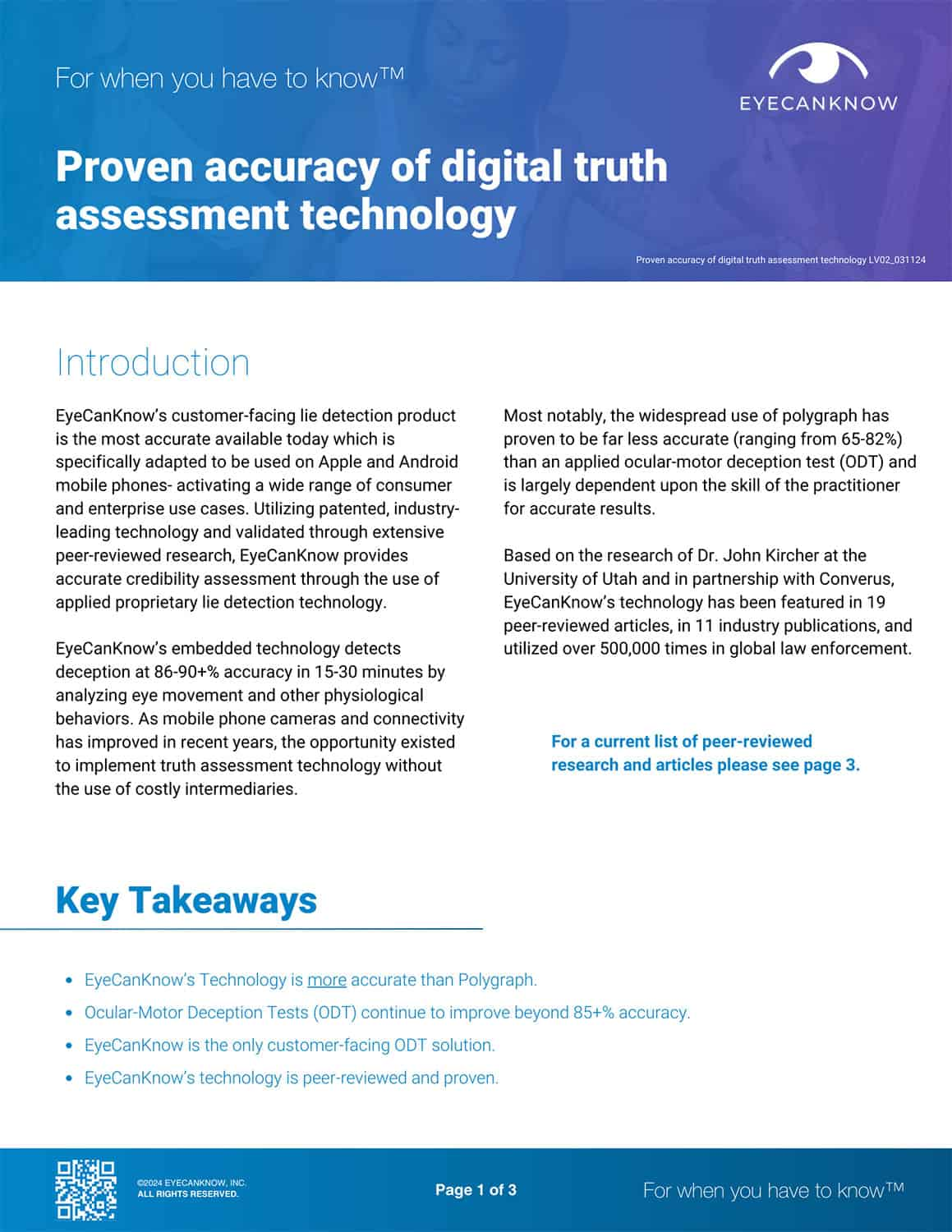What Can Lie Detectors Test For?
New breakthroughs in lie detection technology, like eye lie detector tests are creating pathways people can use to find the truth in their most...
4 min read
 Dr. Bryan K. Ritchie, PhD
:
Mar 18, 2024 2:56:15 PM
Dr. Bryan K. Ritchie, PhD
:
Mar 18, 2024 2:56:15 PM

EyeCanKnow’s customer-facing lie detection product is the most accurate available today which is specifically adapted to be used on Apple and Android mobile phones- activating a wide range of consumer and enterprise use cases. Utilizing patented, industry-leading technology and validated through extensive peer-reviewed research, EyeCanKnow provides accurate credibility assessment through the use of applied proprietary lie detection technology.
EyeCanKnow’s embedded technology detects deception at 86-90+% accuracy in 15-30 minutes by analyzing eye movement and other physiological behaviors. As mobile phone cameras and connectivity has improved in recent years, the opportunity existed to implement truth assessment technology without the use of costly intermediaries.
Most notably, the widespread use of polygraph has proven to be far less accurate (ranging from 65-82%) than an applied ocular-motor deception test (ODT) and is largely dependent upon the skill of the practitioner for accurate results.
Based on the research of Dr. John Kircher at the University of Utah and in partnership with Converus, EyeCanKnow’s technology has been featured in 19 peer-reviewed articles, in 11 industry publications, and utilized over 500,000 times in global law enforcement.
Utilizing the same proven algorithms, protocols, and predictors as Converus’ VerifyEye, EyeCanKnow implements a customer-focused use case and utilizes more advanced cameras and microphones found on most consumer-grade mobile phones, improving data quality and driving test accuracy. Uniquely, EyeCanKnow implements a standardized set of control questions, which enable test customization and personalization across a wide range of behavior-based topics.
The beta version of EyeCanKnow’s mobile-based technology underwent a lab study from October 2022 to March of 2023, achieving a mean accuracy of 79.2%. For context, polygraph screening’s mean accuracy is between 73 to 82%. Our current lab studies for EyeCanKnow’s implementation indicate a mean accuracy of approximately 85% (exceeding our target of 80%) due to ongoing improvements in the technology over the last year.
Ongoing lab studies continue through our partnership with the original research team at Converus, utilizing standardized control procedures to test the mobile application of the applied ocular-motor deception test (ODT) that are almost identical to those used for decades to investigate polygraph techniques. This allows the team to compare results with traditional polygraph techniques and to reproduce the same psychophysiological changes we observe in field settings.
Below, we’ve illustrated how innocent subjects (left panel) show little difference in ocular-motor reaction when questioned about the 3 issues presented (two of which are controls). In the right panel we see a clear correlation between the question being asked and ocular-motor response, specifically pupil dilation, when questioned about “stealing cash,” the behavior being tested.

*Sources 1-11 are peer-reviewed.
1. Kircher, J. C., and Raskin, D. (2016) Laboratory and Field Research on the Ocular-motor Deception Test. European Polygraph Journal, Volume 10, Number 4 (38).
2. Cook, A. E., Hacker, D. J., Webb, A. K., Osher, D., Kristjansson, S., Woltz, D. J., & Kircher, J. C. (2012). Lyin’ Eyes: Ocular-motor Measures of Reading Reveal Deception. Journal of Experimental Psychology: Applied, 18(3), 301-313.
3. Patnaik, P., Woltz, D., Hacker, D., Cooke, A., Francke-Ramm, M., Webb, A., and Kircher, J. (2016) Generalizability of an Ocular-Motor Test for Deception to a Mexican Population. International Journal of Applied Psychology, 6(1): 1-9.
4. Hacker, D. J., Kuhlman, B., & Kircher, J. C., Cook, A.E., and Woltz, D.J. (2014). Detecting Deception Using Ocular Metrics During Reading. In D. C. Raskin, C. R. Honts, & J. C. Kircher (Eds.), Credibility Assessment: Scientific Research and Applications. Elsevier, pp 159-216. (AUTHOR/PUBLICATION REQUIRE PURCHASE)
5. Kuhlman, B. B., Webb, A. K., Patnaik, P., Cook, A. E., Woltz, D. J., Hacker, D. J., & Kircher, J. C. (2011, September). Evoked Pupil Responses Habituate During an Oculomotor Test for Deception. Poster presented at the Society for Psychophysiological Research convention, Boston, MA. (abstract)
6. Patnaik, P., Woltz, D.J., Cook, A.E., Webb, A.K., Raskin, D.C., and Kircher, J.C. (2015, March). Ocular-motor Detection of Deception in Laboratory Settings. Meeting of the American Psychology and Law Society, San Diego, CA.
7. Webb, A. K., Hacker, D.J., Osher, D., Cook, A.E., Woltz, D. J., Kristjansson, S. K., and Kircher, J. C., (2009). Eye Movements and Pupil Size Reveal Deception in Computer Administered Questionnaires. In D. D. Schmorrow, I. V. Estabrooke, & M.Grootjen (Eds.), Foundations of Augmented Cognition. Neuroergonomics and Operational Neuroscience (553-562). Berlin/Heidelberg: Springer-Verlag.
8. Webb, A. K, Honts, C. R., Kircher, J. C., Bernhardt, P.C., and Cook, A. E. (2009). Effectiveness of Pupil Diameter in a Probable-Lie Comparison Question Test for Deception. Legal and Criminal Psychology, 14(2), 279-292. (AUTHOR/PUBLICATION REQUIRE PURCHASE)
9. Kircher, J. C. (2018). Ocular-motor Deception Test. In P. Rosenfeld (Ed.), Detecting Concealed Information and Deception (pp. 187–212), Elsevier Academic Press. (AUTHOR/PUBLICATION REQUIRE PURCHASE)
10. Handler, M., and Nacházelová, M. (2021). Hybrid Polygraph and Ocular-Motor Deception Tests for Screening and Specific-Incident Investigations. In C. Pracana and M. Wang (Eds.), Psychology Applications & Developments VII (pp. 80-92), inScience Press.
11. Bovard, P., Kircher, J., Woltz, D., Hacker, D. & Cook, A. (2019). Effects of direct and indirect questions on the ocular-motor deception test. Polygraph & Forensic Credibility Assessment, 48(1), 40-59.
12. Osher, D. (2006). Multimethod Assessment of Deception: Oculomotor Movement, Pupil Size, and Response Time Measures. (Doctoral dissertation), University of Utah, Department of Educational Psychology.
13. Webb, A.K. (2008). Effects of Motivation, and Item Difficulty on Oculomotor and Behavioral Measures of Deception. (Doctoral dissertation), University of Utah, Department of Educational Psychology. (ISBN: 9780549980032)
14. Patnaik, P. (2013). Ocular-motor Methods for Detecting Deception: Direct Versus Indirect Interrogation. (Master’s Thesis), University of Utah, Department of Educational Psychology.
15. Patnaik, P. (2015). Oculomotor Methods for Detecting Deception: Effects of Practice Feedback and Blocking. Doctoral dissertation, University of Utah, Department of Educational Psychology.
16. Kircher, J. C. (2020). EyeDetect Audio Multi-Issue Comparison Test (AMCT) Development and Validation Summary.
17. Potts, A. (2020). 1, 2, 3 Crimes You’re Out: Ocular-Motor Methods for Detecting Deception In a Multiple-Issue Screening Protocol. (Doctoral dissertation), University of Utah, Department of Educational Psychology.
18. Kircher, J. C. (2021). EyeDetect Hybrid Directed-lie Comparison Test (HDLC) Development and Validation Summary.
19. Kircher, J. C. (2021). EyeDetect Hybrid Multi-Issue Comparison Test (HMCT) Development and Validation Summary.

New breakthroughs in lie detection technology, like eye lie detector tests are creating pathways people can use to find the truth in their most...

Lie detection tests, such as those offered by EyeCanKnow, are pivotal in discerning truth from deception in various situations, including infidelity...